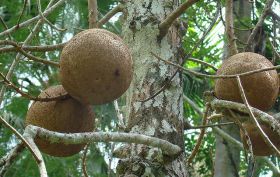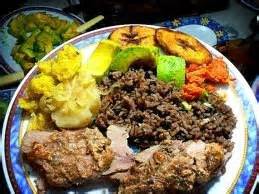How much does food cost in the Panama City, Panama area of San Francisco?
Griselda de Lince - ALTA VITA SPA
Food in the supermarkets in the San Francisco area of Panama City is pretty inexpensive compared to other big cities like Buenos Aires, Argentina or Santiago, Chile.
In San Francisco, Panama, we have two big supermarkets: Riba Smith and Super 99. Both have really good quality and really good brands from all over the world. Here's some examples for prices:
- 1 gallon of milk: $2.80
- 1 dozen eggs: $...
Food in the supermarkets in the San Francisco area of Panama City is pretty inexpensive compared to other big cities like Buenos Aires, Argentina or Santiago, Chile.
In San Francisco, Panama, we have two big supermarkets: Riba Smith and Super 99. Both have really good quality and really good brands from all over the world. Here's some examples for prices:
- 1 gallon of milk: $2.80
- 1 dozen eggs: $ 1.75
- Large package of bread: $1.80
- 1 pound of very good quality meat (what in Panama we call "rincon"): $5.00
- 1 pound of plantains: $1.50
- 1 pound of bananas: $1.00
- 1 mango: $0.50
- 1 papaya: $1.60
- 1 can or bottle of local beer such as Balboa: $0.60
- 1 small Corvina (fish) is $ 4.00 and a large one cost around $7.00
Posted December 4, 2013
Eddie Montes - Panama Property Rentals
 The cost of food in the San Francisco area of Panama City is pretty similar to the food cost in the US. Grocery store items and restaurants are of similar values to the US as well. This is because the San Francisco area is one of the higher-end areas of Panama City. There are various supermarket chains here in Panama and most of them are comparable to what you see in Miami and in other suburban and urban areas in the United States.
The cost of food in the San Francisco area of Panama City is pretty similar to the food cost in the US. Grocery store items and restaurants are of similar values to the US as well. This is because the San Francisco area is one of the higher-end areas of Panama City. There are various supermarket chains here in Panama and most of them are comparable to what you see in Miami and in other suburban and urban areas in the United States.There are other alternatives as well...
 The cost of food in the San Francisco area of Panama City is pretty similar to the food cost in the US. Grocery store items and restaurants are of similar values to the US as well. This is because the San Francisco area is one of the higher-end areas of Panama City. There are various supermarket chains here in Panama and most of them are comparable to what you see in Miami and in other suburban and urban areas in the United States.
The cost of food in the San Francisco area of Panama City is pretty similar to the food cost in the US. Grocery store items and restaurants are of similar values to the US as well. This is because the San Francisco area is one of the higher-end areas of Panama City. There are various supermarket chains here in Panama and most of them are comparable to what you see in Miami and in other suburban and urban areas in the United States.There are other alternatives as well such as the fruit and vegetable markets and the seafood market where prices are significantly lower than the average one-stop shop supermarkets. A typical fish in the US will run you around US $10 to $12 a pound. Some are a little bit less than that. But here in San Francisco, you can buy any fish across the board for $2 to $2.50 a pound. It is significantly cheaper.
In San Francisco, there is also a company named Price Smart, which is similar to a Costco or a BJ’s Wholesale Club, where you can buy bulk items and the prices are similar to the competition in the US for those types of stores as well.
The prices of fruits and vegetables here in San Francisco in the supermarkets are similar to the ones in the US but the fruit stands are significantly cheaper. In these stands you would pay around 1/3 of the price that you would pay in a supermarket for lettuce, potatoes, peppers, and other herbs.
You can save a lot of money if you are only buying fish and fruits, which is pretty much what I do! It’s a lot less expensive aside from the fact that it’s very healthy for you. Not only do you get to eat healthy but your heart rate goes down as well because you are not spending so much money.
(Bala de Cañon or cannonball fruit found in the Panama Canal, Panama, pictured.)
Posted September 20, 2015
Lourdes Townshend
 San Francisco is one of the nicest neighborhoods inside the city of Panamá. And, as in any cosmopolitan and modern city, you can buy the finest products and a great variety of groceries.
San Francisco is one of the nicest neighborhoods inside the city of Panamá. And, as in any cosmopolitan and modern city, you can buy the finest products and a great variety of groceries. The only difference with other cities, for example, in the United States, is the price. Panamá is blessed to have wonderful, warm weather all year round, which is the reason why you can find many seasonal fruits and vegetables that you cannot normally find in...
 San Francisco is one of the nicest neighborhoods inside the city of Panamá. And, as in any cosmopolitan and modern city, you can buy the finest products and a great variety of groceries.
San Francisco is one of the nicest neighborhoods inside the city of Panamá. And, as in any cosmopolitan and modern city, you can buy the finest products and a great variety of groceries. The only difference with other cities, for example, in the United States, is the price. Panamá is blessed to have wonderful, warm weather all year round, which is the reason why you can find many seasonal fruits and vegetables that you cannot normally find in other cities. Only when flooding occurs in the country, prices might go little higher that usual.
For example, you can get a 10 pound papaya (which contains the most fiber and nutrition) for approximately $3.00 the most; or a big pineapple for about a $1.00, while in the US costs about $7.00. These are big differences. Beautiful green, orange or red peppers, culantro (slightly different than cilantro), parsley, onions, garlic, lettuce, celery, chayote, mangoes, squash and other vegetables can be purchased in mixed bags for about $1.00 or $2.00 in some places, or at 50% less than the US in the supermarkets.
And, talking about white rice, Panamá offers a bag of 20 pounds for $10.00, or beautiful fresh oranges from the province of Chiriquí for $2.00 the bag of 100. Who can beat that?
(Typical Panama meal with rice, beans, plantains and yucca, pictured.)
Regarding beef, Panama is famous for their quality. Prices range between $2.68 and $10 (filet mignon), while in the US beef, chicken, pork and seafood is so expensive. Yard fresh eggs, maybe $2.00 per dozen are easy to find everywhere.
Fresh bread in bakeries, some of them, inside the supermarkets are at ridiculously low prices.
Seafood is Panamá specialty. Corvina, considered the best of the best fish, is one of Panamá's best-known dish, and depending the season, runs between $1.75 and $2.75 per pound. Lobsters, crabs, shrimp and other seafood can be found everywhere at very good prices.
What is highly expensive, by Panamanian standards, are some imported items, and, believe or not, the famous "TV dinners" that in the US are lower, but personally, I avoid them, because of the many calories and sodium. Panamanians are more into fresh meals, not pre-cooked or preserved.
The most common dishes are: arroz con pollo, plátano en tentación, frijoles rojos or "porotos", lentejas, flan, ensalada de repollo conremolacha, sopa borracha. (Translation: rice with chicken, sweet yellow plantain, red beans, lentils, flan, cole and beet salad, and drunk soup, which is a dessert specially made for weddings).
Regarding beef, Panama is famous for their quality. Prices range between $2.68 and $10 (filet mignon), while in the US beef, chicken, pork and seafood is so expensive. Yard fresh eggs, maybe $2.00 per dozen are easy to find everywhere.
Fresh bread in bakeries, some of them, inside the supermarkets are at ridiculously low prices.
Seafood is Panamá specialty. Corvina, considered the best of the best fish, is one of Panamá's best-known dish, and depending the season, runs between $1.75 and $2.75 per pound. Lobsters, crabs, shrimp and other seafood can be found everywhere at very good prices.
What is highly expensive, by Panamanian standards, are some imported items, and, believe or not, the famous "TV dinners" that in the US are lower, but personally, I avoid them, because of the many calories and sodium. Panamanians are more into fresh meals, not pre-cooked or preserved.
The most common dishes are: arroz con pollo, plátano en tentación, frijoles rojos or "porotos", lentejas, flan, ensalada de repollo conremolacha, sopa borracha. (Translation: rice with chicken, sweet yellow plantain, red beans, lentils, flan, cole and beet salad, and drunk soup, which is a dessert specially made for weddings).
Posted September 21, 2015


